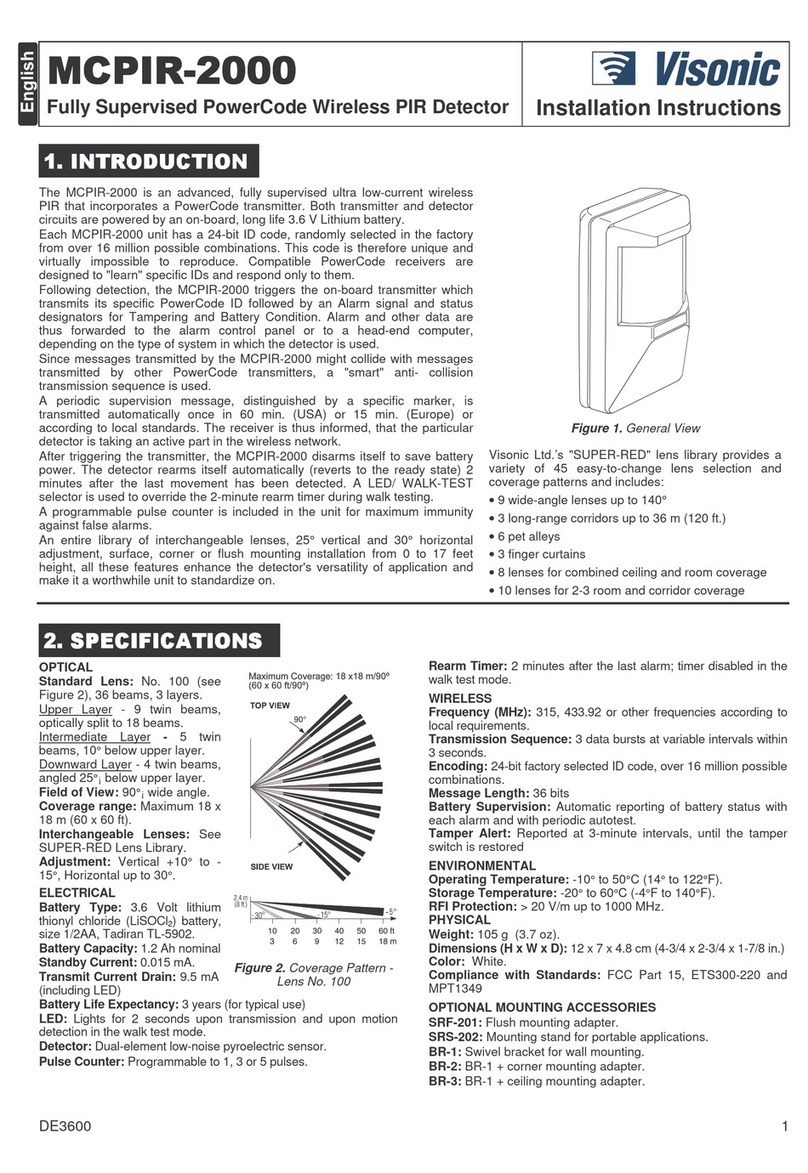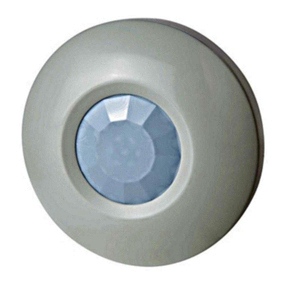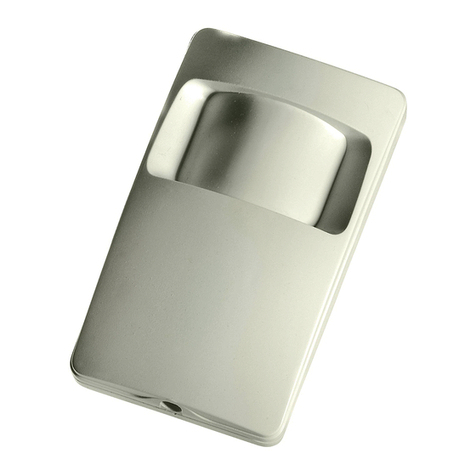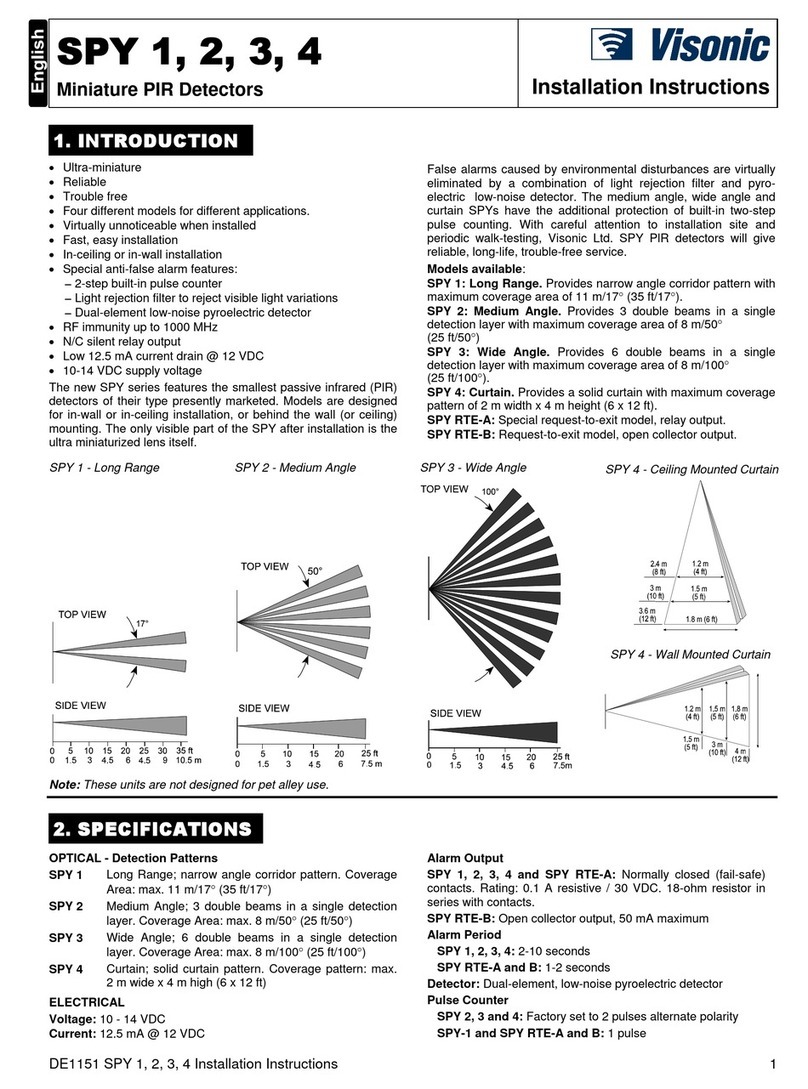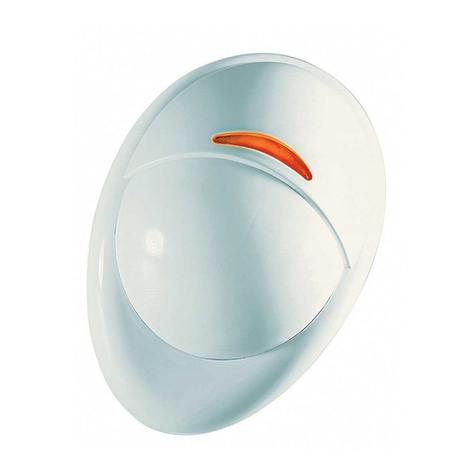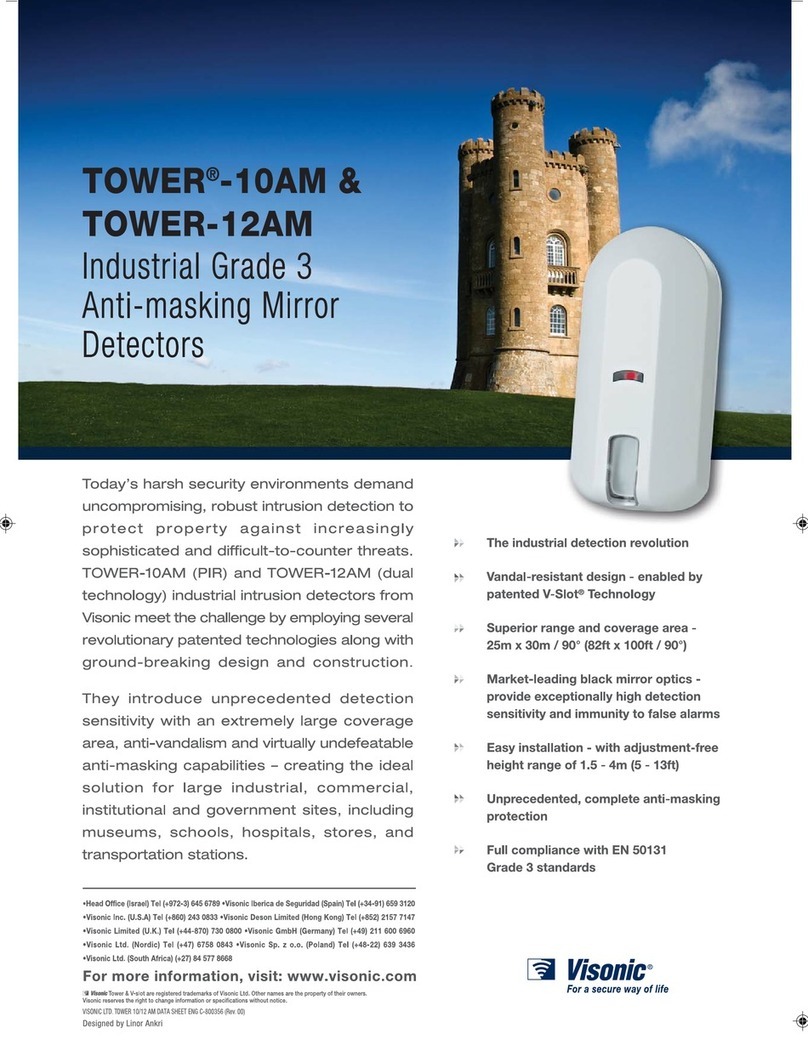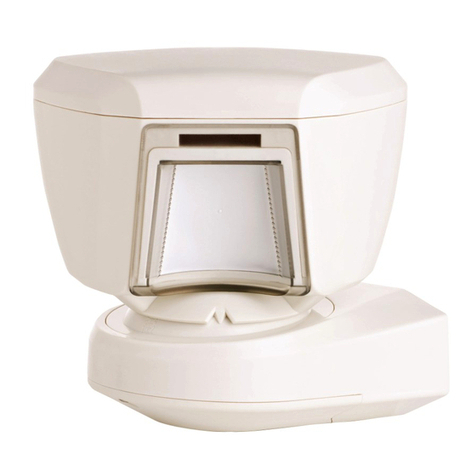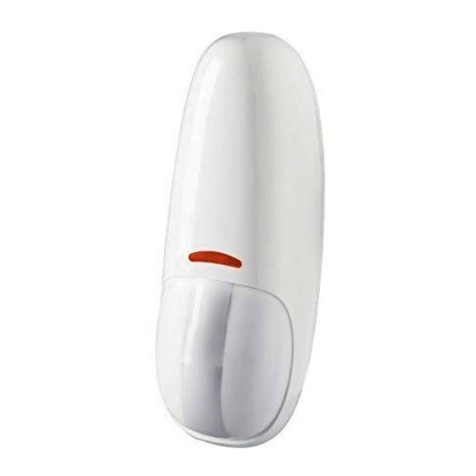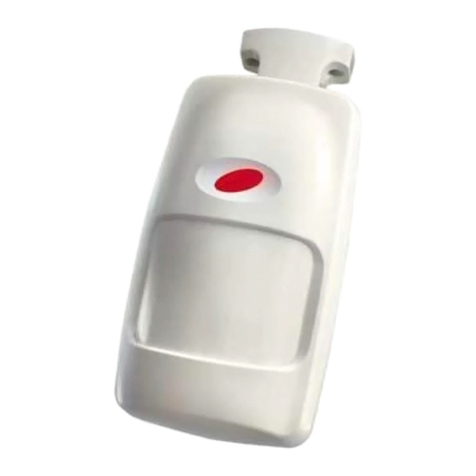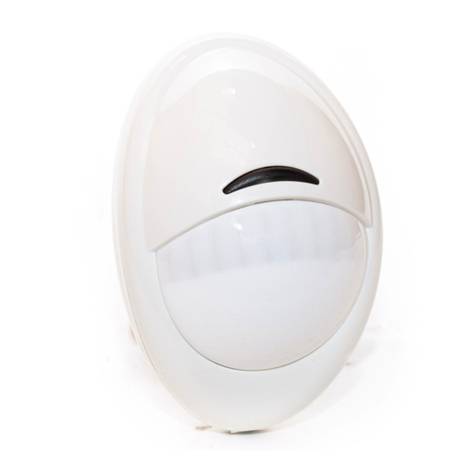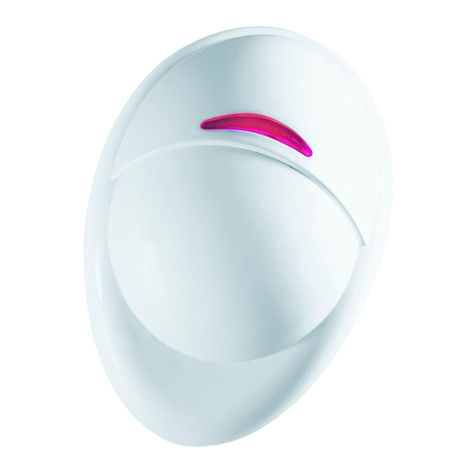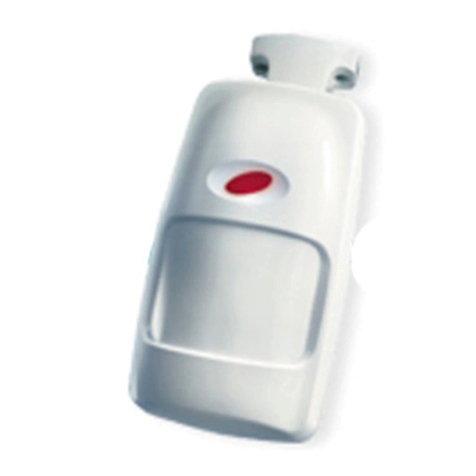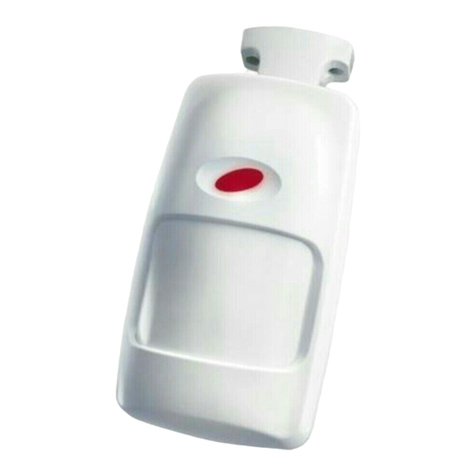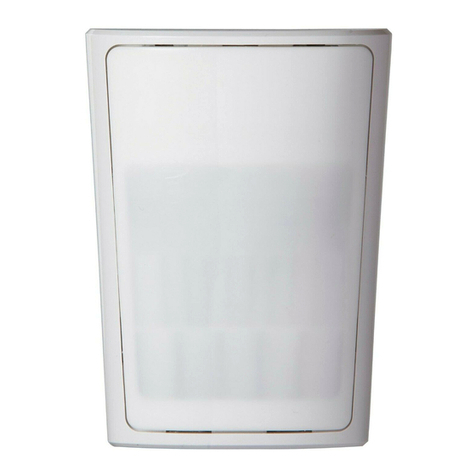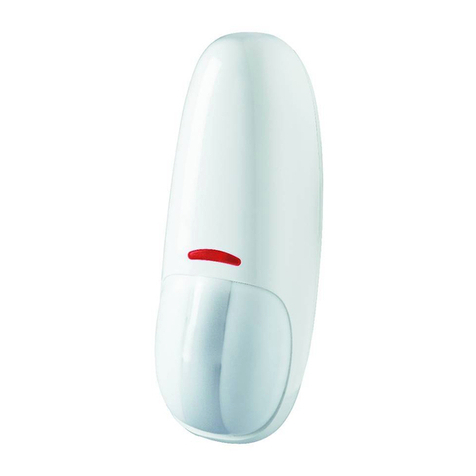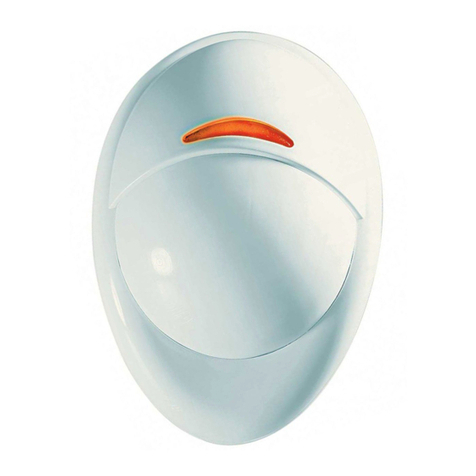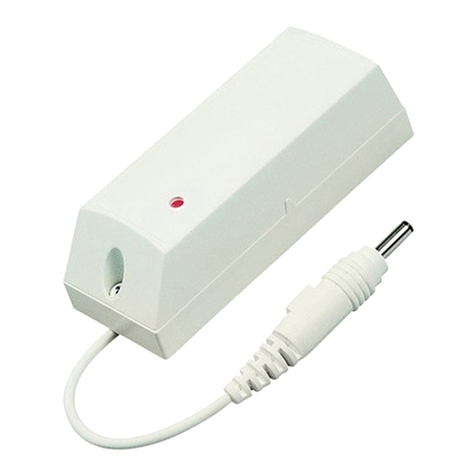
DE1708 3
3.5 Adjusting the Coverage Area
A. Horizontal Adjustment
The SUPER-RED coverage pattern can be adjusted horizontally
approximately ±15° by rotating the lens to the left or right. To
adjust the lens, remove the lens retainers, rotate the lens care-
fully to the desired position and re-lock the lens, as outlined in
Para. 3.1
B. Vertical Adjusting Scale
The vertical adjustment scale (printed on the left side of the p.c.
board) and the plastic pointer on the base indicate (in degrees)
the vertical angle between the upper layer of the coverage pattern
and the horizontal line of the unit.
Table 1 gives the optimum vertical scale adjustment for various
combinations of mounting height and coverage range (indicated
in feet and meters). The scale enables pattern adjustment from
+10° upward to -20° downward, according to the installation
height and the required coverage range.
All SRN-2000E series sensors are shipped from our factory
pre-set to -5° (downward). To change the vertical-pattern adjust-
ment, loosen the screw which fastens the printed circuit board to
the base. Slide the board up or down to the desired degree
setting and tighten the screw firmly.
If no wall exists at the rated range of the detector, or if you want
the pattern to terminate on the floor at a certain distance, the
following formula can be used to estimate the necessary vertical
calibration:
Example: a detector is mounted at 7 ft; you want the pattern to hit
the floor 21 feet away. Applying the formula, you will get:
7 / 21 x 60 = 20
Setting the vertical calibration to –20° will aim the pattern so that
the farthest beam fingers will look at the floor, 21 feet away.
C. Sensitivity Control Adjustment
The potentiometer marked PIR SENS on the PC board should be
set according to the desired coverage range and sensitivity.
For example, if you desire the full 37.5 X 37.5 meters (125 X 125 ft)
range available with the standard lens (E-15), the sensitivity
control must be set to maximum.
If you want to obtain a higher sensitivity, in order to detect slight
movements – replace the standard lens with the high density
lens (No. 51).
Table 1 - Vertical Adjustment Scale
D. Beam Masking Material
A special beam-masking material supplied with each SRN-2000E
series sensor can be used to mask individual segments in the
lens array. Use the material to block segments that are looking at
potential false activation sources (heaters, blowers, pets, etc.) or
unwanted areas.
The material is transparent to visible light but blocks any infrared
energy. In some cases, more than one layer of the lens masking
material may be required to completely block the infrared energy.
3.6 Setting the Load Type Selector
(SRN-2000ET and SRN-2000EF)
Set the load type selector to the appropriate position for your
application. Set the jumper to the LIGHT position to control room
lighting. Set the jumper to A. COND position when controlling an
air conditioning system.
When the A.COND position is selected, there will be a 3-minute
delay period from the moment the operation timer is reset until a
new activation of the relay is possible. This provides an inhibit
period to allow for proper cycling of the compressor.
3.7 Setting the Operation Timer
(SRN-2000ET and SRN-2000EF)
The operation time is set with the potentiometer marked TIME.
The adjustable timer (0.5 or 4 seconds to 20 minutes) is incorpo-
rated to energize the relay for the required operation period. The
countdown restarts as the timer is reset by each detected
movement. The relay therefore stays energized for a full count-
down period following the last detected movement.
3.8 Setting the Daylight Control
(SRN-2000EF only)
The SRN-2000EF features a photocell sensor which allows you to
select the ambient light level at which the unit will be active. The
light level is adjusted with the LIGHT control (see Figure 5).
To permit automatic activation of electric lighting when there is
less natural light – turn the LIGHT control clockwise (towards the
[+] mark). Setting the control all the way to the [+] allows the
lighting to be switched on in total darkness only.
To permit automatic activation of electric lighting when there is
more natural light – turn the LIGHT control counterclockwise
(towards the [–] mark). Setting the control all the way to the [–]
allows the lighting to be switched on in any ambient light – even
in broad daylight.
3.9 Final Testing
Attention! when walk-testing, refer to the coverage pattern which
applies to the lens in actual use.
A. Remove the cover, apply 12VDC power and allow five
minutes for the unit to stabilize before testing.
B. Adjust the vertical calibration angle per Table 1.
C. Set the shortest operation time – the TIME control fully
counterclockwise (SRN-2000ET & EF only).
D. Verify that the load type selector is in the LIGHT position
(SRN-2000ET & EF only).
E. For testing purposes, set the LIGHT control all the way to the
[–], to allow operation in any ambient light (SRN-2000EF
only).
F. Set the LED selector to ON and replace the cover.
G. Walk-test the entire coverage area by walking across the
coverage-pattern segments while observing the LED. The
LED will light up whenever you cross a detection segment.
Keep still a few seconds after each activation, until the LED
goes out and the unit restabilizes.
H. After walk testing, set the LIGHT control to mid-position
(SRN-2000EF only). More accurate adjustment will be
possible in the evening, at the actual dimness level beyond
which you wish the lights to come on automatically.
I. At the end of the test, you may disable the LED by setting the
LED selector to OFF.
3.10 Test Point (TP)
The test point terminal (TP) provides a good means for analyzing
the sensor in the event of an environmental problem or suspicion
of a faulty unit.
Using a DC voltmeter, connect the positive lead to the TP
terminal and the negative lead to the (–) power terminal. For easy
testing, temporarily connect a length of two-conductor wire to
these terminals and route the wires out. Replace the cover on top
of the wire. Connect the meter to the ends of these wires.
Cover the detector with a piece of cardboard. The meter should
indicate approximately 2.0 Volts DC (between 1.6 and 2.4 VDC).
If these limits are exceeded, the detector unit should be replaced.
Uncover the lens and allow the meter to stabilize. Do not stand
within the detector’s coverage pattern. Any motion or environ-
mental disturbance detected by the unit will cause the meter to
deflect above or below the 2.0 VDC level. Meter variations of
more than ±1 Volt (above 3 Volts or below 1 Volt) will trigger the
load-switching relay.
